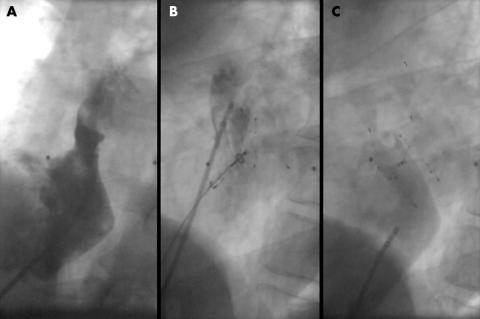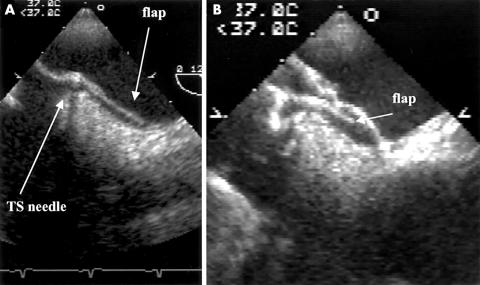Abstract
Two patients with long tunnel-type patent foramen ovale presented for elective transcatheter closure following transient ischaemic attack and stroke. Right to left shunting was confirmed on transthoracic and transoesophageal echocardiography. A new technique that used a transseptal procedure was devised to enable closure of the tunnel-type patent foramen ovale using the CardioSEAL transseptal occluder to avoid “bunching up” of the device and residual transatrial shunting.
Keywords: transseptal puncture, tunnel-type patent foramen ovale, patent foramen ovale, device closure
Transcatheter closure of secundum atrial septal defect and patent foramen ovale (PFO) has been extensively addressed over the past decade.1–5 Specific indications for transcatheter PFO closure include a history of transient ischaemic attacks, cerebrovascular accident, and orthodeoxia-platypnoea.6,7 PFO may vary in location and may be of heterogeneous morphology, including the presence of a long tunnel-type PFO.8 We describe two patients with transient ischaemic attacks in whom a new technique was devised to enable transcatheter PFO closure.
Case 1
A 65 year old man was referred for transcatheter PFO closure after experiencing two transient ischaemic attacks. Transoesophageal echocardiography (TOE) confirmed right to left shunting at the PFO level. Elective cardiac catheterisation was undertaken. The pulmonary to system blood flow ratio was 1:1. TOE and angiography showed a long tunnel-type PFO, which was 24 mm in length (fig 1). A transseptal puncture was performed after exchanging the 9 French gauge sheath in the femoral vein for an 11 French gauge transseptal sheath. A 40 mm CardioSEAL septal occluder (Nitinol Medical Technologies, Boston, Massachusetts, USA) was advanced through the sheath into the left atrium. The left atrial legs were deployed in the left atrium and the device was retracted against the atrial septum with release of the right atrial legs on the systemic venous side.
Figure 1.
(A) Lateral view angiogram showing the long tunnel-type patent foramen ovale. (B) Lateral view showing the cardiomarker catheter in the patent foramen ovale tunnel and the CardioSEAL device delivered through the transseptally created aperture in the tunnel. (C) The device occluding the patent foramen ovale. Note that the flap is seated under the left atrial legs with no right to left shunting.
The CardioSEAL device was placed in apposition to the septum, although there was prominent septal hypertrophy between the legs of the device. Angiography following device implant showed no residual atrial level shunting (fig 1).
Case 2
A 43 year old man was referred for transcatheter closure of PFO after developing two strokes over three years. TOE showed a long tunnel-type PFO, which measured 20 mm in length. Elective transcatheter closure was undertaken. TOE showed a long tunnel between the flap of the valve and the septal wall of the PFO, which measured 20 mm in length and 11 mm in diameter (fig 2). The balloon diameter was 6.5 mm. It was elected to approach the defect transseptally to avoid bunching it up and to enable the device to flatten the valve of the foramen against the septum. A transseptal puncture was performed, a 0.035 inch Superstiff wire (Boston Scientific, Quincy, Massachusetts, USA) was advanced into the left atrium, and the femoral vein sheath was exchanged for an 11 French gauge transseptal sheath. A 40 mm CardioSEAL septal occluder was deployed in the left atrium and placed in apposition to the septum, flattening the valve of the foramen against the septum. There was a tiny residual angiographic right to left shunt across the inferior aspect of the device, which had been resolved the following day on echocardiography.
Figure 2.
(A) Transoesophageal echocardiogram showing the long patent foramen tunnel with the transseptal (TS) needle abutting the flap. (B) Transesophageal echocardiography showing the tunnel flap embraced by the left atrial legs.
DISCUSSION
Over the past decade several devices have been studied in effecting atrial septal defect and PFO closure.1–6 Indications for PFO closure include a history of transient ischaemic attack, cerebrovascular accident, and rarer conditions such as platypnoea-orthodeoxia.7,8
Patients who present with transient ischaemic attack or cerebrovascular accident secondary to PFO must have complete occlusion of their defect to abolish the risk of residual right to left shunting and recurrent neurological events. Of interest is the reported higher risk of stroke or transient ischaemic attack in patients with right to left shunting and high membrane mobility, which includes patients with tunnel-type PFO.8 Even following complete occlusion of a PFO, however, there may remain a residual risk of further neurological insult.9 The presence of a long tunnel-type PFO may give rise to technical problems in achieving device implantation. Transseptal puncture through the stretched flap of the tunnel, stretched by the catheter, is easy to perform and is without complication. A study proved that transseptal puncture was extremely safe over an 18 year period, including through baffles and interatrial patches.10 In the first case presented, the use of a transseptal approach additionally allowed the device to be aligned appropriately with the septal flap rather than “bunching” the septal flap together in one area of the device.
In conclusion, the transseptal puncture may safely be used in patients with long tunnel-type PFO, in whom a more central approach through the septal flap may result in an improved closure profile of the defect.
REFERENCES
- 1.Latson LA, Zahn EM, Wilson N. Helex septal occluder for closure of atrial septal defects. Curr Interv Cardiol Rep 2000;2:268–73. [PubMed] [Google Scholar]
- 2.Waight DJ, Koeing PR, Cao QL, et al. Transcatheter closure of secundum atrial septal defects using the Amplatzer septal occluder: clinical experience and technical considerations. Curr Interv Cardiol Rep 2000;2:70–7. [PubMed] [Google Scholar]
- 3.Carminati M, Giusti S, Hausdorf G, et al. A European multicenter experience using the CardioSEAL and Starflex double umbrella devices to close interatrial communications holes within the oval fossa. Cardiol Young 2000;10:519–26. [DOI] [PubMed] [Google Scholar]
- 4.Rao PS, Berger F, Rey C, et al. Results of transvenous occlusion of secundum atrial septal defects with the fourth generation buttoned device: comparison with first, second and third generation devices: International Buttoned Device Trial Group. J Am Coll Cardiol 2000;36:583–92. [DOI] [PubMed] [Google Scholar]
- 5.Pedra CA, Pihkala J, Lee KJ, et al. Transcatheter closure of atrial septal defects using the Cardio-Seal implant. Heart 2000;84:320–6. [DOI] [PMC free article] [PubMed] [Google Scholar]
- 6.Cheng TO. Transcatheter closure of patent foramen ovale: a definitive treatment for platypnea-orthodeoxia. Cathet Cardiovasc Interv 2000;51:120. [DOI] [PubMed] [Google Scholar]
- 7.Waight DJ, Cao QL, Hijazi ZM. Closure of patent foramen ovale in patients with orthodeoxia-platypnea using the amplatzer devices. Cathet Cardiovasc Interv 2000;50:195–8. [DOI] [PubMed] [Google Scholar]
- 8.Ussia GP, Momenah TS, Ursell P, et al. Evaluation of the morphology of the oval fossa for placement of devices. Cardiol Young 2000;10:502–9. [DOI] [PubMed] [Google Scholar]
- 9.Haug J, Landzberg MJ, Jenkins KJ, et al. Closure of patent foramen ovale for paradoxical emboli: intermediate-term risk of recurrent neurological events following transcatheter device placement. J Am Coll Cardiol 2000;35:1311–6. [DOI] [PubMed] [Google Scholar]
- 10.El Said HG, Ing FF, Grifka RG, et al. 18-year experience with transeptal procedures through baffles, conduits, and other intra-atrial patches. Cathet Cardiovasc Interv 2000;50:434–9. [DOI] [PubMed] [Google Scholar]




